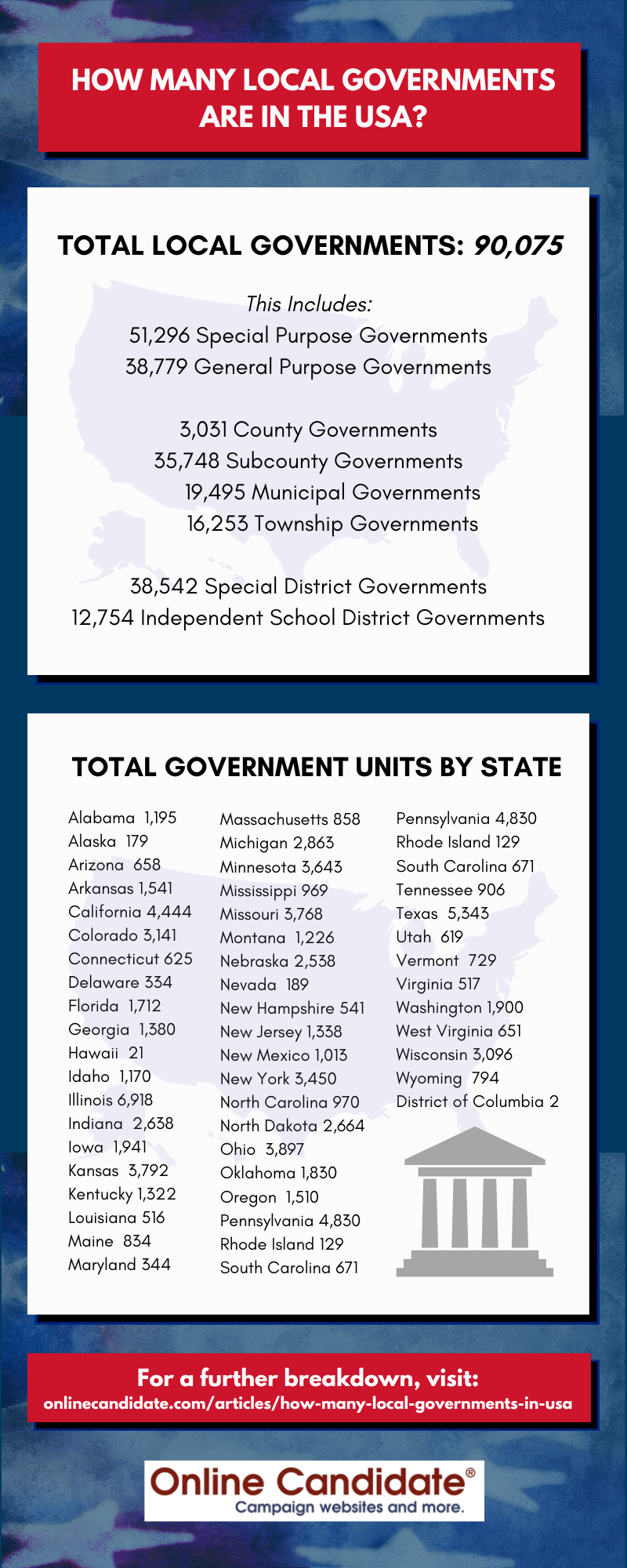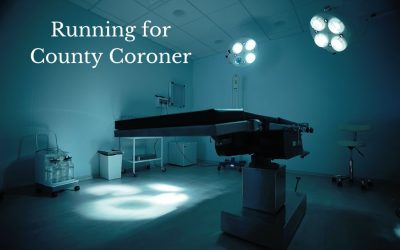So You Want To Run For District Attorney? Here’s How To Get Started
Running for district attorney is a challenging and rewarding experience. A DA is responsible for prosecuting criminal cases within their jurisdiction. They work closely with law enforcement agencies when investigating crimes and evidence. They determine whether criminal charges are filed and prosecute defendants in court. As chief prosecutors, district attorneys have significant power to shape justice in their districts.
Like judicial elections, district attorney races tend to fly under the voter’s radar. Most people can’t name their county’s district attorney, so building name recognition is an important election strategy.
NOTE: In some states, district attorneys are called county prosecutors, state attorney, or prosecuting attorney. They usually serve in office for a four-year term. For this article, we will refer to the elected position as district attorney.
How to run a campaign for district attorney:
Why do you want to become district attorney?
When thinking about running for district attorney, it is important to consider your personal reasons and motivations for seeking this position. Your beliefs and values should align with the responsibilities of the position. This will help you craft a clear platform and message for your campaign.
Many candidates want to work within the criminal justice system. For those who want a safer community, it provides a way to prosecute criminals and help ensure that victims receive justice. Elected prosecutors also act to protect civil rights and liberties. They have latitude in how they charge people with crimes. They can offer second chances through treatment and rehabilitation.
Knowing what drives you will help you create an interesting campaign message. Ideally, your story should resonate with voters.
“Ask any lawyer – if a prosecutor thinks he can win a case, he’ll prosecute it.” – Robert B. Weide
Check your eligibility to run
Not every state elects its chief prosecutors, so you’ll need to live in one of the 47 states that do. For example, in Arkansas, there are 28 prosecuting attorneys across the state. In New York, there are 62 county district attorneys. Rhode Island has only one Attorney General, who has primary duties for the entire state.
As an aspiring district attorney, you’ll need to meet certain eligibility requirements. These are determined by your state or municipality. Here are some common requirements:
-
-
- You’ll need to be a United States citizen of at least 18 years old, registered to vote, and who meets the state residency requirements.
- In most states, you’ll need a JD from an accredited law school.
- You may also be required to have experience working as a lawyer. District attorney candidates must usually be licensed to practice law in the state where they seek election.
-
Experience as a prosecutor or defense attorney, or having held other elected positions in the past, can be helpful. Trial experience, knowing how to advocate for clients, and understanding how the courtroom works can give you an advantage. Even private sector work, such as working as a general counsel for a business or non-profit, can help prepare you for the DA position.
Finally, to properly file and get on the ballot, you’ll need to collect petition signatures from registered voters. The actual number and how they must be submitted vary by state. Contact your local board of elections to review those rules.

Are there legal issues with running for DA?
Like all political candidates, candidates for district attorney must follow state and federal election laws and regulations. You can be penalized with fines and even disqualification from the race if you do not follow the rules. Here are specific legal issues that district attorney candidates should watch for:
-
-
- Campaign finance violations: You must comply with laws governing the amount, the source, and any reporting requirements, of all campaign contributions.
- Conflicts of interest: Avoid even the appearance of conflict. For example, accepting contributions from individuals or organizations could appear to influence a candidate’s decisions as DA. This can raise concerns about impartiality and fairness. District attorney candidates running for reelection should be particularly sensitive to this.
- Disclosure issues: As a candidate, you must state your sources of income and investments. You must be transparent in this, as this information will become publicly available.
- Defamation and libel: Be careful how you speak about opponents and others. False or defamatory statements on the campaign trail can get you in legal trouble.
- Voting rights violations: Do not violate any laws protecting the right to vote. This includes issues such as voter intimidation or discrimination.
- Ethics violations: You will be held to high ethical standards due to the nature of the office you seek. Ethical violations can result in disciplinary action or even removal from the ballot.
- Government and political activities: If you are already working in a government position, there are restrictions on using government resources for any campaigning purposes.
-
If you currently hold a different elected office, such as a city council member or a judge, you might not be able to keep that position. Some states prohibit individuals from holding two elected positions at once. Check your state’s laws and seek legal advice, if necessary.
“The great joy of being a prosecutor is that you don’t take whatever case walks in the door. You evaluate the case; you make your best judgment. You only go forward if you believe that the defendant is guilty.” – Merrick Garland
How to begin your campaign
The next important step is to file your required paperwork and petitions with your local election board. This typically includes a statement of candidacy, financial disclosure forms, and nomination papers.
You’ll need to provide personal details, along with your education, work experience, and current residence. You’ll also need to file additional documents, like a Statement of Economic Interests (SEI). An SEI lists any financial interests or potential conflicts of interest that you may have.
It’s important to follow your filing requirements and deadlines. If you don’t, your candidacy could be disqualified. It’s at this time that many candidates come up with a campaign slogan, create a logo and branding, and begin building their campaign websites.

The cost of your DA race will be determined by a number of factors.
How much money will you need to raise?
Running for district attorney can be expensive. You’ll need money for advertising, campaign materials, and staff. Campaign costs can often run as much or more as any other local office.
The amount of money you’ll need will be unique to your particular race. Some if it will depend on your district size and the total number of voters. The number of opponents you’ll face in the primary and general elections will also influence the cost. A typical DA race costs tens of thousands of dollars. However, some races cost a lot less due to being uncontested.
To get an idea of how much money your campaign will need, put together a detailed list of all your estimated costs. This includes printing, polling, venue costs, office space rental, and staff salaries. Advertising is another large expense. Add the estimated cost of running TV, radio, and online advertising.
Once you know your campaign’s potential costs, you can start figuring out how to pay for them. Most candidates start by reaching out to friends, family, and colleagues for initial contributions. In time, you’ll need to connect with more potential donors.
Fundraising laws vary by state and jurisdiction. There are hard limits on how much money an individual donor can give to a specific candidate.
Find out how much previous district attorney races have cost in your area, and set a fundraising goal based on that.
Get our Online Campaign Tips Guide.
It’s FREE right now!
Create your campaign committee
A campaign committee is the core group of people who will run and manage your campaign. They can include volunteers or paid consultants. Find people with different skills, like fundraising, marketing, and organizing, at the grassroots level. Each member should be assigned clear roles and responsibilities.
Here are the basic steps to putting together a campaign committee:
-
-
- Designate a treasurer. Like other political campaigns, a district attorney campaign must have a designated treasurer. This person is responsible for managing the campaign’s finances. A treasurer makes sure that all contributions are legal and within legal limits. Treasurers also file required financial reports and statements. This person should be detail-oriented and familiar with election finance.
- Open a campaign bank account: You’ll need a dedicated bank account to deposit and spend campaign funds. All financial transactions must be properly recorded. Under no circumstances can campaign funds be commingled with personal funds.
- Make a campaign budget. Work with your campaign treasurer to make a detailed campaign budget that lists all expected costs and sources of income.
- Put together your campaign team. In addition to a treasurer, you’ll need to fill other positions. To start, you’ll want to have a field director, a communications director, and a campaign manager in place. Each person will manage a different part of your campaign, such as fundraising, advertising, and voter outreach.
- Make sure election laws are followed. Your campaign committee and staff must be aware of and follow the proper election laws and rules.
-
A strong, talented team will help make sure that your campaign for district attorney goes smoothly, follows all laws and rules, and has the best chance of succeeding.
Secure your endorsements
Endorsements from influential community leaders, elected officials, and organizations can boost your credibility. Reach out to community leaders, such as elected officials, and business owners. These individuals can provide valuable support and help mobilize voters in your district.
Consider seeking endorsements from law enforcement organizations, such as police unions or associations. There may also be advocacy groups and other organizations that align with your campaign’s platform.
There should be no apparent potential conflicts of interest from those who endorse you. For example, if an endorser has a significant interest that is or may come before the DA’s office, it could be perceived as a conflict of interest. Endorsements from law enforcement organizations or law firms could raise concerns about potential bias or conflicts of interest, particularly if your platform involves criminal justice reform measures.
Be transparent about any endorsements you receive. Be prepared to address any concerns or questions raised by voters or the media.
Make your announcement
Once you officially and publicly announce your candidacy, you can put your strategy to work. It’s important to get your name before the voting public. Do it through events, through online promotion, in mailings and through signage.
District attorneys often communicate with the media to provide information to the public about cases. As a candidate, you’ll also deal with the media as you hold press conferences and give interviews.
Maintain a good working relationship with the press, as you will deal with them a great deal as a DA.
Many of our clients who ended up winning did so because they were able to get their name and message out to voters better than their opponents.
Becoming a prosecutor can be a rewarding career choice. It allows you to work on important criminal cases and make a real impact in your county or state. You will have a lot of influence over proposed criminal justice reform.
Good luck!
From election campaign website hosting to marketing services, Online Candidate can help launch your digital presence.
How Many Local Governments Are In The USA? (Infographic)
If you think there’s too much government in the United States, you may be on to something. There are over 90,000 government units in the US, with over $3.4 trillion spent annually on direct expenditures for state and local governments. From state, county, local towns and villages all the way to special districts and independent school districts, that makes for a huge amount of bureaucracy.
A breakdown of the total number of local governments in the United States by state and government type can be found in the infographic below:

This data was compiled from the 2017 Census of Governments: Organization, published in 2019. In addition to the federal government and the 50 state governments, the Census Bureau recognizes five basic types of local governments. Three are general-purpose governments: County, municipal, and township governments. Legislative provisions for school district and special district governments are more diverse. Single-function and multiple-function districts, authorities, commissions, boards, and other entities have varying degrees of autonomy that varies by state.
Government Breakdown by State
| State | Total | Type of Government |
|---|---|---|
| United States | 90,075 | Total Local Government Units |
| United States | 51,296 | Special Purpose |
| United States | 38,779 | General Purpose |
| United States | 3,031 | County |
| United States | 35,748 | Subcounty |
| United States | 19,495 | Subcounty – Municipal |
| United States | 16,253 | Subcounty – Township |
| United States | 38,542 | Special Purpose – Special District |
| United States | 12,754 | Special Purpose – Independent School District |
| Alabama | 1,195 | Total Local Government Units |
| Alabama | 667 | Special Purpose |
| Alabama | 528 | General Purpose |
| Alabama | 67 | County |
| Alabama | 461 | Subcounty |
| Alabama | 461 | Subcounty – Municipal |
| Alabama | X | Subcounty – Township |
| Alabama | 530 | Special Purpose – Special District |
| Alabama | 137 | Special Purpose – Independent School District |
| Alaska | 179 | Total Local Government Units |
| Alaska | 15 | Special Purpose |
| Alaska | 164 | General Purpose |
| Alaska | 15 | County |
| Alaska | 149 | Subcounty |
| Alaska | 149 | Subcounty – Municipal |
| Alaska | X | Subcounty – Township |
| Alaska | 15 | Special Purpose – Special District |
| Alaska | X | Special Purpose – Independent School District |
| Arizona | 658 | Total Local Government Units |
| Arizona | 552 | Special Purpose |
| Arizona | 106 | General Purpose |
| Arizona | 15 | County |
| Arizona | 91 | Subcounty |
| Arizona | 91 | Subcounty – Municipal |
| Arizona | X | Subcounty – Township |
| Arizona | 310 | Special Purpose – Special District |
| Arizona | 242 | Special Purpose – Independent School District |
| Arkansas | 1,541 | Total Local Government Units |
| Arkansas | 965 | Special Purpose |
| Arkansas | 576 | General Purpose |
| Arkansas | 75 | County |
| Arkansas | 501 | Subcounty |
| Arkansas | 501 | Subcounty – Municipal |
| Arkansas | X | Subcounty – Township |
| Arkansas | 730 | Special Purpose – Special District |
| Arkansas | 235 | Special Purpose – Independent School District |
| California | 4,444 | Total Local Government Units |
| California | 3,905 | Special Purpose |
| California | 539 | General Purpose |
| California | 57 | County |
| California | 482 | Subcounty |
| California | 482 | Subcounty – Municipal |
| California | X | Subcounty – Township |
| California | 2,894 | Special Purpose – Special District |
| California | 1,011 | Special Purpose – Independent School District |
| Colorado | 3,141 | Total Local Government Units |
| Colorado | 2,808 | Special Purpose |
| Colorado | 333 | General Purpose |
| Colorado | 62 | County |
| Colorado | 271 | Subcounty |
| Colorado | 271 | Subcounty – Municipal |
| Colorado | X | Subcounty – Township |
| Colorado | 2,628 | Special Purpose – Special District |
| Colorado | 180 | Special Purpose – Independent School District |
| Connecticut | 625 | Total Local Government Units |
| Connecticut | 446 | Special Purpose |
| Connecticut | 179 | General Purpose |
| Connecticut | X | County |
| Connecticut | 179 | Subcounty |
| Connecticut | 30 | Subcounty – Municipal |
| Connecticut | 149 | Subcounty – Township |
| Connecticut | 429 | Special Purpose – Special District |
| Connecticut | 17 | Special Purpose – Independent School District |
| Delaware | 334 | Total Local Government Units |
| Delaware | 274 | Special Purpose |
| Delaware | 60 | General Purpose |
| Delaware | 3 | County |
| Delaware | 57 | Subcounty |
| Delaware | 57 | Subcounty – Municipal |
| Delaware | X | Subcounty – Township |
| Delaware | 255 | Special Purpose – Special District |
| Delaware | 19 | Special Purpose – Independent School District |
| District of Columbia | 2 | Total Local Government Units |
| District of Columbia | 1 | Special Purpose |
| District of Columbia | 1 | General Purpose |
| District of Columbia | X | County |
| District of Columbia | 1 | Subcounty |
| District of Columbia | 1 | Subcounty – Municipal |
| District of Columbia | X | Subcounty – Township |
| District of Columbia | 1 | Special Purpose – Special District |
| District of Columbia | X | Special Purpose – Independent School District |
| Florida | 1,712 | Total Local Government Units |
| Florida | 1,234 | Special Purpose |
| Florida | 478 | General Purpose |
| Florida | 66 | County |
| Florida | 412 | Subcounty |
| Florida | 412 | Subcounty – Municipal |
| Florida | X | Subcounty – Township |
| Florida | 1,139 | Special Purpose – Special District |
| Florida | 95 | Special Purpose – Independent School District |
| Georgia | 1,380 | Total Local Government Units |
| Georgia | 691 | Special Purpose |
| Georgia | 689 | General Purpose |
| Georgia | 152 | County |
| Georgia | 537 | Subcounty |
| Georgia | 537 | Subcounty – Municipal |
| Georgia | X | Subcounty – Township |
| Georgia | 511 | Special Purpose – Special District |
| Georgia | 180 | Special Purpose – Independent School District |
| Hawaii | 21 | Total Local Government Units |
| Hawaii | 17 | Special Purpose |
| Hawaii | 4 | General Purpose |
| Hawaii | 3 | County |
| Hawaii | 1 | Subcounty |
| Hawaii | 1 | Subcounty – Municipal |
| Hawaii | X | Subcounty – Township |
| Hawaii | 17 | Special Purpose – Special District |
| Hawaii | X | Special Purpose – Independent School District |
| Idaho | 1,170 | Total Local Government Units |
| Idaho | 926 | Special Purpose |
| Idaho | 244 | General Purpose |
| Idaho | 44 | County |
| Idaho | 200 | Subcounty |
| Idaho | 200 | Subcounty – Municipal |
| Idaho | X | Subcounty – Township |
| Idaho | 808 | Special Purpose – Special District |
| Idaho | 118 | Special Purpose – Independent School District |
| Illinois | 6,918 | Total Local Government Units |
| Illinois | 4,090 | Special Purpose |
| Illinois | 2,828 | General Purpose |
| Illinois | 102 | County |
| Illinois | 2,726 | Subcounty |
| Illinois | 1,297 | Subcounty – Municipal |
| Illinois | 1,429 | Subcounty – Township |
| Illinois | 3,204 | Special Purpose – Special District |
| Illinois | 886 | Special Purpose – Independent School District |
| Indiana | 2,638 | Total Local Government Units |
| Indiana | 976 | Special Purpose |
| Indiana | 1,662 | General Purpose |
| Indiana | 91 | County |
| Indiana | 1,571 | Subcounty |
| Indiana | 567 | Subcounty – Municipal |
| Indiana | 1,004 | Subcounty – Township |
| Indiana | 687 | Special Purpose – Special District |
| Indiana | 289 | Special Purpose – Independent School District |
| Iowa | 1,941 | Total Local Government Units |
| Iowa | 899 | Special Purpose |
| Iowa | 1,042 | General Purpose |
| Iowa | 99 | County |
| Iowa | 943 | Subcounty |
| Iowa | 943 | Subcounty – Municipal |
| Iowa | X | Subcounty – Township |
| Iowa | 551 | Special Purpose – Special District |
| Iowa | 348 | Special Purpose – Independent School District |
| Kansas | 3,792 | Total Local Government Units |
| Kansas | 1,799 | Special Purpose |
| Kansas | 1,993 | General Purpose |
| Kansas | 103 | County |
| Kansas | 1,890 | Subcounty |
| Kansas | 625 | Subcounty – Municipal |
| Kansas | 1,265 | Subcounty – Township |
| Kansas | 1,493 | Special Purpose – Special District |
| Kansas | 306 | Special Purpose – Independent School District |
| Kentucky | 1,322 | Total Local Government Units |
| Kentucky | 787 | Special Purpose |
| Kentucky | 535 | General Purpose |
| Kentucky | 118 | County |
| Kentucky | 417 | Subcounty |
| Kentucky | 417 | Subcounty – Municipal |
| Kentucky | X | Subcounty – Township |
| Kentucky | 614 | Special Purpose – Special District |
| Kentucky | 173 | Special Purpose – Independent School District |
| Louisiana | 516 | Total Local Government Units |
| Louisiana | 152 | Special Purpose |
| Louisiana | 364 | General Purpose |
| Louisiana | 60 | County |
| Louisiana | 304 | Subcounty |
| Louisiana | 304 | Subcounty – Municipal |
| Louisiana | X | Subcounty – Township |
| Louisiana | 83 | Special Purpose – Special District |
| Louisiana | 69 | Special Purpose – Independent School District |
| Maine | 834 | Total Local Government Units |
| Maine | 330 | Special Purpose |
| Maine | 504 | General Purpose |
| Maine | 16 | County |
| Maine | 488 | Subcounty |
| Maine | 23 | Subcounty – Municipal |
| Maine | 465 | Subcounty – Township |
| Maine | 232 | Special Purpose – Special District |
| Maine | 98 | Special Purpose – Independent School District |
| Maryland | 344 | Total Local Government Units |
| Maryland | 164 | Special Purpose |
| Maryland | 180 | General Purpose |
| Maryland | 23 | County |
| Maryland | 157 | Subcounty |
| Maryland | 157 | Subcounty – Municipal |
| Maryland | X | Subcounty – Township |
| Maryland | 164 | Special Purpose – Special District |
| Maryland | X | Special Purpose – Independent School District |
| Massachusetts | 858 | Total Local Government Units |
| Massachusetts | 502 | Special Purpose |
| Massachusetts | 356 | General Purpose |
| Massachusetts | 5 | County |
| Massachusetts | 351 | Subcounty |
| Massachusetts | 53 | Subcounty – Municipal |
| Massachusetts | 298 | Subcounty – Township |
| Massachusetts | 417 | Special Purpose – Special District |
| Massachusetts | 85 | Special Purpose – Independent School District |
| Michigan | 2,863 | Total Local Government Units |
| Michigan | 1,007 | Special Purpose |
| Michigan | 1,856 | General Purpose |
| Michigan | 83 | County |
| Michigan | 1,773 | Subcounty |
| Michigan | 533 | Subcounty – Municipal |
| Michigan | 1,240 | Subcounty – Township |
| Michigan | 436 | Special Purpose – Special District |
| Michigan | 571 | Special Purpose – Independent School District |
| Minnesota | 3,643 | Total Local Government Units |
| Minnesota | 923 | Special Purpose |
| Minnesota | 2,720 | General Purpose |
| Minnesota | 87 | County |
| Minnesota | 2,633 | Subcounty |
| Minnesota | 853 | Subcounty – Municipal |
| Minnesota | 1,780 | Subcounty – Township |
| Minnesota | 590 | Special Purpose – Special District |
| Minnesota | 333 | Special Purpose – Independent School District |
| Mississippi | 969 | Total Local Government Units |
| Mississippi | 589 | Special Purpose |
| Mississippi | 380 | General Purpose |
| Mississippi | 82 | County |
| Mississippi | 298 | Subcounty |
| Mississippi | 298 | Subcounty – Municipal |
| Mississippi | X | Subcounty – Township |
| Mississippi | 432 | Special Purpose – Special District |
| Mississippi | 157 | Special Purpose – Independent School District |
| Missouri | 3,768 | Total Local Government Units |
| Missouri | 2,427 | Special Purpose |
| Missouri | 1,341 | General Purpose |
| Missouri | 114 | County |
| Missouri | 1,227 | Subcounty |
| Missouri | 944 | Subcounty – Municipal |
| Missouri | 283 | Subcounty – Township |
| Missouri | 1,897 | Special Purpose – Special District |
| Missouri | 530 | Special Purpose – Independent School District |
| Montana | 1,226 | Total Local Government Units |
| Montana | 1,043 | Special Purpose |
| Montana | 183 | General Purpose |
| Montana | 54 | County |
| Montana | 129 | Subcounty |
| Montana | 129 | Subcounty – Municipal |
| Montana | X | Subcounty – Township |
| Montana | 730 | Special Purpose – Special District |
| Montana | 313 | Special Purpose – Independent School District |
| Nebraska | 2,538 | Total Local Government Units |
| Nebraska | 1,550 | Special Purpose |
| Nebraska | 988 | General Purpose |
| Nebraska | 93 | County |
| Nebraska | 895 | Subcounty |
| Nebraska | 529 | Subcounty – Municipal |
| Nebraska | 366 | Subcounty – Township |
| Nebraska | 1,281 | Special Purpose – Special District |
| Nebraska | 269 | Special Purpose – Independent School District |
| Nevada | 189 | Total Local Government Units |
| Nevada | 154 | Special Purpose |
| Nevada | 35 | General Purpose |
| Nevada | 16 | County |
| Nevada | 19 | Subcounty |
| Nevada | 19 | Subcounty – Municipal |
| Nevada | X | Subcounty – Township |
| Nevada | 137 | Special Purpose – Special District |
| Nevada | 17 | Special Purpose – Independent School District |
| New Hampshire | 541 | Total Local Government Units |
| New Hampshire | 297 | Special Purpose |
| New Hampshire | 244 | General Purpose |
| New Hampshire | 10 | County |
| New Hampshire | 234 | Subcounty |
| New Hampshire | 13 | Subcounty – Municipal |
| New Hampshire | 221 | Subcounty – Township |
| New Hampshire | 129 | Special Purpose – Special District |
| New Hampshire | 168 | Special Purpose – Independent School District |
| New Jersey | 1,338 | Total Local Government Units |
| New Jersey | 752 | Special Purpose |
| New Jersey | 586 | General Purpose |
| New Jersey | 21 | County |
| New Jersey | 565 | Subcounty |
| New Jersey | 324 | Subcounty – Municipal |
| New Jersey | 241 | Subcounty – Township |
| New Jersey | 233 | Special Purpose – Special District |
| New Jersey | 519 | Special Purpose – Independent School District |
| New Mexico | 1,013 | Total Local Government Units |
| New Mexico | 875 | Special Purpose |
| New Mexico | 138 | General Purpose |
| New Mexico | 33 | County |
| New Mexico | 105 | Subcounty |
| New Mexico | 105 | Subcounty – Municipal |
| New Mexico | X | Subcounty – Township |
| New Mexico | 779 | Special Purpose – Special District |
| New Mexico | 96 | Special Purpose – Independent School District |
| New York | 3,450 | Total Local Government Units |
| New York | 1,863 | Special Purpose |
| New York | 1,587 | General Purpose |
| New York | 57 | County |
| New York | 1,530 | Subcounty |
| New York | 601 | Subcounty – Municipal |
| New York | 929 | Subcounty – Township |
| New York | 1,185 | Special Purpose – Special District |
| New York | 678 | Special Purpose – Independent School District |
| North Carolina | 970 | Total Local Government Units |
| North Carolina | 318 | Special Purpose |
| North Carolina | 652 | General Purpose |
| North Carolina | 100 | County |
| North Carolina | 552 | Subcounty |
| North Carolina | 552 | Subcounty – Municipal |
| North Carolina | X | Subcounty – Township |
| North Carolina | 318 | Special Purpose – Special District |
| North Carolina | X | Special Purpose – Independent School District |
| North Dakota | 2,664 | Total Local Government Units |
| North Dakota | 946 | Special Purpose |
| North Dakota | 1,718 | General Purpose |
| North Dakota | 53 | County |
| North Dakota | 1,665 | Subcounty |
| North Dakota | 357 | Subcounty – Municipal |
| North Dakota | 1,308 | Subcounty – Township |
| North Dakota | 767 | Special Purpose – Special District |
| North Dakota | 179 | Special Purpose – Independent School District |
| Ohio | 3,897 | Total Local Government Units |
| Ohio | 1,570 | Special Purpose |
| Ohio | 2,327 | General Purpose |
| Ohio | 88 | County |
| Ohio | 2,239 | Subcounty |
| Ohio | 931 | Subcounty – Municipal |
| Ohio | 1,308 | Subcounty – Township |
| Ohio | 904 | Special Purpose – Special District |
| Ohio | 666 | Special Purpose – Independent School District |
| Oklahoma | 1,830 | Total Local Government Units |
| Oklahoma | 1,163 | Special Purpose |
| Oklahoma | 667 | General Purpose |
| Oklahoma | 77 | County |
| Oklahoma | 590 | Subcounty |
| Oklahoma | 590 | Subcounty – Municipal |
| Oklahoma | X | Subcounty – Township |
| Oklahoma | 621 | Special Purpose – Special District |
| Oklahoma | 542 | Special Purpose – Independent School District |
| Oregon | 1,510 | Total Local Government Units |
| Oregon | 1,234 | Special Purpose |
| Oregon | 276 | General Purpose |
| Oregon | 36 | County |
| Oregon | 240 | Subcounty |
| Oregon | 240 | Subcounty – Municipal |
| Oregon | X | Subcounty – Township |
| Oregon | 1,004 | Special Purpose – Special District |
| Oregon | 230 | Special Purpose – Independent School District |
| Pennsylvania | 4,830 | Total Local Government Units |
| Pennsylvania | 2,205 | Special Purpose |
| Pennsylvania | 2,625 | General Purpose |
| Pennsylvania | 66 | County |
| Pennsylvania | 2,559 | Subcounty |
| Pennsylvania | 1,013 | Subcounty – Municipal |
| Pennsylvania | 1,546 | Subcounty – Township |
| Pennsylvania | 1,691 | Special Purpose – Special District |
| Pennsylvania | 514 | Special Purpose – Independent School District |
| Rhode Island | 129 | Total Local Government Units |
| Rhode Island | 90 | Special Purpose |
| Rhode Island | 39 | General Purpose |
| Rhode Island | X | County |
| Rhode Island | 39 | Subcounty |
| Rhode Island | 8 | Subcounty – Municipal |
| Rhode Island | 31 | Subcounty – Township |
| Rhode Island | 86 | Special Purpose – Special District |
| Rhode Island | 4 | Special Purpose – Independent School District |
| South Carolina | 671 | Total Local Government Units |
| South Carolina | 355 | Special Purpose |
| South Carolina | 316 | General Purpose |
| South Carolina | 46 | County |
| South Carolina | 270 | Subcounty |
| South Carolina | 270 | Subcounty – Municipal |
| South Carolina | X | Subcounty – Township |
| South Carolina | 274 | Special Purpose – Special District |
| South Carolina | 81 | Special Purpose – Independent School District |
| South Dakota | 1,916 | Total Local Government Units |
| South Dakota | 637 | Special Purpose |
| South Dakota | 1,279 | General Purpose |
| South Dakota | 66 | County |
| South Dakota | 1,213 | Subcounty |
| South Dakota | 311 | Subcounty – Municipal |
| South Dakota | 902 | Subcounty – Township |
| South Dakota | 487 | Special Purpose – Special District |
| South Dakota | 150 | Special Purpose – Independent School District |
| Tennessee | 906 | Total Local Government Units |
| Tennessee | 469 | Special Purpose |
| Tennessee | 437 | General Purpose |
| Tennessee | 92 | County |
| Tennessee | 345 | Subcounty |
| Tennessee | 345 | Subcounty – Municipal |
| Tennessee | X | Subcounty – Township |
| Tennessee | 455 | Special Purpose – Special District |
| Tennessee | 14 | Special Purpose – Independent School District |
| Texas | 5,343 | Total Local Government Units |
| Texas | 3,871 | Special Purpose |
| Texas | 1,472 | General Purpose |
| Texas | 254 | County |
| Texas | 1,218 | Subcounty |
| Texas | 1,218 | Subcounty – Municipal |
| Texas | X | Subcounty – Township |
| Texas | 2,798 | Special Purpose – Special District |
| Texas | 1,073 | Special Purpose – Independent School District |
| Utah | 619 | Total Local Government Units |
| Utah | 340 | Special Purpose |
| Utah | 279 | General Purpose |
| Utah | 29 | County |
| Utah | 250 | Subcounty |
| Utah | 250 | Subcounty – Municipal |
| Utah | X | Subcounty – Township |
| Utah | 299 | Special Purpose – Special District |
| Utah | 41 | Special Purpose – Independent School District |
| Vermont | 729 | Total Local Government Units |
| Vermont | 436 | Special Purpose |
| Vermont | 293 | General Purpose |
| Vermont | 14 | County |
| Vermont | 279 | Subcounty |
| Vermont | 42 | Subcounty – Municipal |
| Vermont | 237 | Subcounty – Township |
| Vermont | 159 | Special Purpose – Special District |
| Vermont | 277 | Special Purpose – Independent School District |
| Virginia | 517 | Total Local Government Units |
| Virginia | 194 | Special Purpose |
| Virginia | 323 | General Purpose |
| Virginia | 95 | County |
| Virginia | 228 | Subcounty |
| Virginia | 228 | Subcounty – Municipal |
| Virginia | X | Subcounty – Township |
| Virginia | 193 | Special Purpose – Special District |
| Virginia | 1 | Special Purpose – Independent School District |
| Washington | 1,900 | Total Local Government Units |
| Washington | 1,580 | Special Purpose |
| Washington | 320 | General Purpose |
| Washington | 39 | County |
| Washington | 281 | Subcounty |
| Washington | 281 | Subcounty – Municipal |
| Washington | X | Subcounty – Township |
| Washington | 1,285 | Special Purpose – Special District |
| Washington | 295 | Special Purpose – Independent School District |
| West Virginia | 651 | Total Local Government Units |
| West Virginia | 364 | Special Purpose |
| West Virginia | 287 | General Purpose |
| West Virginia | 55 | County |
| West Virginia | 232 | Subcounty |
| West Virginia | 232 | Subcounty – Municipal |
| West Virginia | X | Subcounty – Township |
| West Virginia | 309 | Special Purpose – Special District |
| West Virginia | 55 | Special Purpose – Independent School District |
| Wisconsin | 3,096 | Total Local Government Units |
| Wisconsin | 1,172 | Special Purpose |
| Wisconsin | 1,924 | General Purpose |
| Wisconsin | 72 | County |
| Wisconsin | 1,852 | Subcounty |
| Wisconsin | 601 | Subcounty – Municipal |
| Wisconsin | 1,251 | Subcounty – Township |
| Wisconsin | 734 | Special Purpose – Special District |
| Wisconsin | 438 | Special Purpose – Independent School District |
| Wyoming | 794 | Total Local Government Units |
| Wyoming | 672 | Special Purpose |
| Wyoming | 122 | General Purpose |
| Wyoming | 23 | County |
| Wyoming | 99 | Subcounty |
| Wyoming | 99 | Subcounty – Municipal |
| Wyoming | X | Subcounty – Township |
| Wyoming | 617 | Special Purpose – Special District |
| Wyoming | 55 | Special Purpose – Independent School District |
According to the data sources, there are a total of 90,075 local governments in the United States. Of these, 51,296 are Special Purpose Governments and 38,779 are General Purpose Governments. Note that while not a state, Washington DC is included in the numbers. Illinois has the largest number of entities, while Hawaii has the least.
Many special purpose and district offices can be easier to run for because members or officers are appointed.
County Governments
There are 3,031 County Governments and 35,748 Subcounty Governments. 19,495 of these are Municipal Governments, and 16,253 are Township Governments. Subcounty areas consist of incorporated places such as cities, boroughs, villages, along with towns and townships.
Special Purpose Governments
Of the 51,296 Special Purpose Governments, 38,542 are Special Districts and 12,754 are Independent School Districts. An independent school district (ISD) is a type of school district that operates independent from any municipality, county, or state.
Elected and Appointed Officials
The US has a strong tradition of local government with a large number of elected officials, such as state legislators, mayors, city council members and even special district officials. Within these governing entities, there are over 500,000 elected officials. And very state, county and municipality has their own set of laws, so understanding the structure of government in your area is important if you decide to start a run for office.
X / Twitter Tips for Political Campaigns
X, formerly called Twitter, is a social messaging tool that presents great opportunities for political candidates to create branding, exposure and word-of-mouth advertising. It’s easy to set up and easy to use. Not only that, the service helps candidates save time and effort in communicating to the voter base.
Through Twitter, users can ‘follow’ others and others can follow them. It allows users to post status updates, or ‘tweets’, that are limited to 280 characters. These updates are communicated to followers, who can read, respond or even share the tweets with others.
Using X / Twitter for your political campaign:
- Claim @YourCampaign
- Modify your account settings and look
- Make updates regularly
- Build your following
- Is political advertising allowed on X?
- Don’t make these Twitter mistakes
- Twitter Tweet ideas for political campaigns and candidates

The big political X / Twitter tip – Claim @YourCampaign
Even if you don’t plan to use Twitter right away, be sure you claim your name or campaign name as your Twitter handle, even if you don’t intend to start using Twitter immediately. If you put it off, there’s a risk that your name could be taken by someone else, similar to domain name squatting.
Some candidates choose to use their existing personal account when they run for office. If you already have a Twitter account, you could use that one or create a brand new handle for your campaign. The advantage to using a variant of you name (@JoeSmith) rather than a year (@JoeSmith2021) or a position (@Smith4Mayor) is that the account won’t become outdated after an election.
Modify your account settings and look
Add your information and website link to the account settings. Brand your profile design by customizing the color settings and background. Use your campaign colors and logo to create a consistent look with your campaign website and other social media accounts.
Make regular updates and set up a post schedule
Even though your campaign may not have many resources for social media, keeping a campaign Twitter account up-to-date should not take much time. How often you post is less important than posting regularly, no matter what the schedule may be. Maintain momentum by posting on a daily or weekly schedule. Anything less than weekly, and you may start to lose followers.
See below for the section on campaign tweet ideas.
Post relevant news and content
Candidates don’t have to just post updates on what they are doing or thinking. Look at how other prominent politicians use Twitter for style and content ideas.
Political candidates and campaigns tend to post:
- News articles
- Campaign press releases
- Endorsements
- Website updates
- Event alerts
This material helps keep followers up to date. Don’t forget to add relevant images to draw more attention to your posts.
Pin a popular tweet to the top of your page. This might be a relevant tweet about your campaign or your most popular post. It should be something that would cause others to want to stay informed.
TIP: Try tweet-enhancing tools like Buffer. Use hashtags, retweets and shortened links to give variety to your posts. Be authentic in your tone and invite feedback. Some people may message you directly.
Build your following
In the beginning, you will use your personal contacts as your initial followers. Once you are up and running, Twitter will provide recommendations of others to follow. If you do this, some of these people will follow you back. This will help expose you to others who may be interested in following your campaign. Journalists and other media sources use Twitter to follow candidates, so be sure to follow them back.
You can also use X to connect one-on-one with supporters. It’s a great way to address immediate topics and concerns and really engage with others. Use it as a listening tool to learn more about voter moods, issue ideas and the latest news.
Tip: Leverage your other social media sites. Share your account in posts and updates, and ask your followers to also follow you on Twitter.
Make Twitter part of your larger online presence
Twitter is only one method of online communication. Your website, blog, Facebook and other social accounts should be kept up to date as well. Because Twitter is designed for ‘small bites’ of information, you can update your status far more frequently than you would on Facebook without annoying your followers.
Is political advertising allowed on X?
In 2019, Twitter suspended political advertising on its platform. In the days before that you could advertise to your state or district, but you needed a fairly large budget. Statewide or congressional campaigns were more likely have the ad budget to run ads. After the ability to run political ads ended, candidates focused on building follower engagement on other online advertising options.
In September 2023, Twitter/X allowed political advertising. It remained so through the 2024 election season. How long this will remain or how the rules will shift is anyone’s guess…
Don’t make these Twitter mistakes
Political candidates and campaigns have several reasons for using Twitter. They may want to build overall public exposure, establish branding, share ideas and information, and increase voter support. While Twitter is simple to set up and use, it’s not without its quirks. To attract and keep more followers, avoid these common mistakes.
- Sending tweets or posts from the wrong user account. Many people have multiple Twitter or X accounts. If you have a personal account and another for your political campaign, make sure you are logged into the proper account before you tweet. This mistake is more common than you may think, especially in the business world.
- Confusing a direct message with a general tweet. Former New York Representative Anthony Weiner learned the differences between a direct message and regular open tweet when a lewd photo was posted to his account. Make sure you know who you are sending your messages to. Never assume that any electronic communications are private or will remain so.
- Posting bad material. Keep an eye out on your Follower list and re-tweet relevant items. Don’t do it blindly, though. Make sure you check your sources. You don’t want to retweet false information.
- Being overly emotional. A little emotion in your posts is fine. After all, you don’t want to give the impression that you are a campaigning robot. On the other hand, too much complaining, vitriol and anger can backfire.
- The quality, not quantity, of your followers is important. You’re running to win an election, not a social media contest. Having a large number of follower doesn’t really matter if the bulk of your audience is fake.
- Not focusing on what works. Keep track of what produces the most shares, repost and engagement from your audience. Use this information to improve your outreach. It can help you grow your audience and even increase the amount of online donations you bring in.
Related: 5 Common Campaign Twitter Mistakes
Tweet ideas for political candidates
Starting up a Twitter account is easy, but it can tough keeping your tweets varied and engaging. For greater context and reach, your posts should include a related image or video.
Here are some campaign tweet ideas:
- Candidate comment on recent events regarding your state or district.
- Interesting or educational information related to a major campaign issue.
- Negative information about your opponent(s).
- Ask followers to stay current with your campaign by signing up for your email list.
- Reminders about an upcoming event – and why it will be great!
- Live Tweets during an event.
- Followup about a recent event.
- Latest poll numbers about you.
- Latest poll numbers about your opponent.
- Ask what issues are important to your followers.
- One sentence summary of your latest blog post, with link.
- Mentions of you in a news article.
- Location/district news, with comment.
- Support requests, usually related to another event.
- Volunteer requests, usually tied to a specific event or activity.
- Updates about campaign staff that may be of general interest.
- Fundraising goal status.
- Notification of new billboard/large banner location.
- Announcement that signs are available.
- Link to new video or campaign ad.
- Latest endorsement announcements.
- Shout outs to helpful individuals or organizations.
Related: X / Twitter Post Ideas for Political Candidates
Don’t forget to keep an eye out on your follower list and re-tweet relevant items with hashtags and usernames. Keep your updates varied and frequent. Your strategy should be to engage followers rather than simply broadcast to them.
For more information on getting your campaign started on X, visit the Political Content page.
Good luck and good tweeting!
Sign up to our email list below for more political and social media marketing tips and ideas.
Tips For Designing Your Campaign Yard Signs
Campaign yard signs are an important element in political campaigning. Over time, a single campaign sign can be seen by hundreds or even thousands of people. Multiply that effect by the total number of signs promoting a campaign, and you have a powerful way to build candidate name recognition.
Key Takeaways
- Have your political logo created before you order campaign yard signs.
- Keep your campaign sign layouts clean and limit the number of colors used.
- Don’t wait until the last minute to order yard signs. Printers are busy during election season.
Consider creating your logo early in the campaign
 A good part of your yard sign will be taken up by your campaign logo. A logo is an important part of a political campaign yard sign because it helps people recognize who you are and what you represent. It also helps people remember your name more easily when they see it again in the future.
A good part of your yard sign will be taken up by your campaign logo. A logo is an important part of a political campaign yard sign because it helps people recognize who you are and what you represent. It also helps people remember your name more easily when they see it again in the future.
Having your logo created by a professional who is familiar with printing will make it easier when it comes to printing. The original graphic files must be in a print format, not a web image format. In the design, use a block-style font. Script is harder to read, especially when driving by. Select your colors early on. If your logo has many colors or uses a color gradient, it will make printing your signs more expensive.
Custom website design packages from Online Candidate come with a logo design, and we can give you the original, high-resolution files.
Generally, the candidate’s name should be the largest element on the sign. The office sought can also be included.
Tips for designing your campaign yard signs
- Do not put too much information on the sign: They are generally read by motorists passing by. Text should be large enough to read from a distance. At best, you have only a few seconds to relay your message. The phrases “re-elect” and “vote for” are basically redundant. Stick to a simple, clear message that conveys your campaign’s main objectives and values.
- Consider your color scheme: This will increase the impact of the sign. Red, white, and blue are traditional favorites. Other combos of color such as black and red or blue and yellow can work well, too.
- Don’t make your yard signs too small: They will be harder to notice and read, and they will give the impression that your campaign itself is “small.” A typical yard sign is 12″ x 24″, but going for 18″ x 24″ or larger signs can produce more impact. Consider the location of the sign and make sure the size of the sign is appropriate for the area.
- Utilize the right materials: Choose durable materials that can withstand the elements and are easy to install. Corrugated plastic or aluminum signs are popular choices because they are lightweight, weather-resistant, and long-lasting.
- Avoid using photographs: Photos often don’t reproduce well on smaller signs.
- Make your signs match the look and feel of your campaign literature, including your fliers, brochures, and the design of your political website.
- Test the design: Before ordering a large number of yard signs, consider ordering a small test batch to gauge the visibility and effectiveness of the design. This can help you make necessary adjustments before ordering a large quantity.
- Don’t wait until the last minute to order signs. Printers get busy during election season, and it’s often first-come, first-serve. You don’t want a delay in getting your printed materials. Put your orders in as early as you can.
There are several types of yard signs that are typically used, each with their own advantages and weaknesses. Your campaign’s unique needs should guide your choice of sign type(s).

While traditional yard sign designs often have a similar look, they are done this way because they are effective.
Is there an alternative to printed signs?
In addition to traditional printed yard signs, homemade political yard signs are useful for small to medium-sized campaigns. They are generally larger, and they can be used to promote a specific message or fight back against a negative attack. With larger text sizes available, be sure that even your larger signs are clearly readable from a distance.
Put a plan together and have volunteers ready to deploy when the signs arrive in the mail. Organize the routes and placements for your signs. You will need space to assemble your signs and stakes. They will take time to assemble. Have volunteers make the deliveries.
When you are ready to put out your signs, put the bulk of them out in a short period of time, such as over a weekend. The impact will be greater than putting them up gradually.
Signage is an inexpensive way to advertise. A good yard sign campaign will get a candidate’s name before voters. Name recognition is a strong factor behind many election victories, so you want to make as strong and positive an impression as possible.
Related: Guide: When Is The Best Time To Order Campaign Signage?
 10% Off on Super Cheap Signs. Use Code: ONLCAN10
10% Off on Super Cheap Signs. Use Code: ONLCAN10
5 Myths About Political Candidate Websites
 You know what they say about assumptions. In political web development, we run into a lot of them. In our experience of working with political campaigns, here are our top five myths about political campaign sites that can cost candidates visitors and support.
You know what they say about assumptions. In political web development, we run into a lot of them. In our experience of working with political campaigns, here are our top five myths about political campaign sites that can cost candidates visitors and support.
Myth 1: A candidate website is a digital brochure
A website can be a digital brochure, but that limits the possibilities. The political candidate website is the digital hub that pulls everything together. It’s the central location for updated campaign news, as a donation and volunteer portal, and a means to get voters to follow you via social media and email. Don’t limit the possibilities of the medium!
Myth 2: If you create a campaign website, it will immediately show up on Google
We get question this a lot. A client will contact us, saying, “Hey, my site launched two days ago, and I don’t see it on Google.”
Our first question is whether there are any sites or pages linking to the site. 4 out of 5 times, the answer is no. For a website to show up on Google, you usually need to do one or more of the following:
- Create links to the site from other pages, such as your social media pages.
- Create a campaign Google Account and set up Google Analytics (GA4) for your site.
- Submit a press release online and to your local media.
- Notify others through social media and encourage them to share.
- Have other sites link to your site.
- Time. The earlier you launch a site, the more ‘authority’ the site gains over time.
In other words, site owners need to take action to get search engines to notice their websites.
Myth 3: Large graphics and minimal text is good idea
Actually, it’s not. Sometimes a candidate’s ‘About Us’ page ranks higher than the site’s home page. This is because the About page has substantial content about the candidate, while the home page may just have a large picture and little text – or that copy is written in the first person.
Search engines cannot (fully) read images, so if you want to rank well for something, you need actual content for the search engines to read.
Myth 4: Everyone knows who you are
Too many campaign websites fail to put the most critical information into their site. We see some candidates not include the location of the state or municipality in the text. Sometimes they don’t even list the election date! If you want people to vote for you, you need to tell them when (and where) to vote. Don’t assume that anyone who comes to your website knows anything about you or your campaign.
Myth 5: 30 days before the election is enough time to campaign online
If you wait until a month before an election to begin online campaigning, you may as well not bother. Building an online campaign takes time. Even if you do not have a website right away, candidates should be building an initial online following through social media. Those followers will eventually become your primary online donors, volunteers, and advocates.
Keep these tips in mind as you begin your political efforts. Good luck!
Online Candidate makes it easy for state and local candidates to start a political website and build their online presence.
So You Want To Run For Coroner? Here’s How To Get Started
Most people associate the position of coroner with high-profile criminal investigations and forensic science. However, the role of a county coroner goes beyond investigations. The position involves serving the community by identifying deceased individuals, determining the cause and manner of death, and providing support to grieving families.
If you’re interested in running for county coroner, here’s how to begin.
Understanding the Qualifications
To become a coroner, you need to possess specific qualifications. It’s important to research and understand the specific requirements set by your county or state.
- Educational requirements: It’s beneficial to have a bachelor’s degree in a natural science field like biology, chemistry, or forensic science.
- Training and certification: Depending on local regulations, coroners may need to obtain certification as death investigators. These certifications help ensure the expertise and knowledge necessary to effectively carry out duties.
- Understanding legal and investigative procedures: Coroners need to be familiar with the legal and investigative processes. This includes understanding local laws, regulations, and protocols related to death investigations.
- Compassion and empathy: Dealing with deceased individuals and grieving families requires sensitivity, compassion, and empathy. Strong interpersonal skills and the ability to communicate effectively are vital for a coroner’s role.
Research your local election laws, consult the county elections board or relevant authorities, and familiarize yourself with the necessary paperwork and deadlines for submitting your candidacy.
Discovering Your Motivation
Before embarking on a coroner’s campaign, you should know why you want to run for the position. Consider the challenges and issues that affect your county and its residents. What policies would you advocate for to address these issues? What makes you the ideal candidate compared to your opponents? Identifying your motivation and vision will help shape your campaign platform.
“Mine is a gruesome job, but for a scientist with a love for the mechanics of the human body, a great one.”
– Working Stiff: Two Years, 262 Bodies, and the Making of a Medical Examiner
Identifying Key Issues
Focus on key issues that matter to voters and taxpayers. These are specific topics that can have a significant impact on communities:
- Death Investigations: Improve the efficiency and accuracy of death investigations to provide closure to families and ensure public safety.
- Forensic Science: Promote the use of cutting-edge forensic techniques and technologies to enhance investigative capabilities.
- Public Health: This includes acting as an advocate for public health initiatives and programs that contribute to the community’s well-being.
- Crisis Response: Develop comprehensive plans to handle mass casualty incidents, natural disasters, or pandemics.
- Collaboration: You may want your office to strengthen partnerships with law enforcement agencies, medical professionals, and community organizations to ensure effective cooperation in investigations.
Research previous coroner campaigns to learn what issues were considered important by voters.
Eligibility and Ballot Requirements
Every elected position has specific requirements for candidate to be on the ballot. Some common requirements include:
- Age: Generally, candidates must be at least 18 years old, but specific age requirements may vary.
- Education: Educational requirements can range from a high school diploma to specific degrees or certifications.
- Residency: Candidates are typically required to be residents of the county for a certain period.
- Other ballot requirements may require collecting a minimum number of signatures from registered voters.
Consult your county elections board or relevant authorities to ensure you meet the criteria.
Planning Your Campaign Finances
Any successful political campaign requires financial resources. Your level of fundraising will vary depending on the competitiveness of the position. You should attempt to estimate the budget you’ll need. Research campaign finance disclosures from previous coroner races to identify spending trends and set a practical budget. Early fundraising efforts should focus on reaching out to potential supporters who share your vision.
- Campaign budget: Evaluate the expenses, such as advertising, marketing materials, campaign events, and staff. Research the spending trends of previous campaigns in your area will help you get a sense of the budget range.
- Fundraising strategies: Develop a fundraising plan to secure the necessary funds. This includes reaching out to potential donors, organizing fundraising events, utilizing online fundraising platforms, and building a strong network of supporters.
Early donors are instrumental in jump-starting your fundraising efforts. To start, reach out to friends, family, personal contacts, and organizations that you are a member of.
Building Popularity and Support
To gain traction in your campaign, it’s crucial to increase your local popularity and engage with the community. Consider the following strategies:
- Attend Community Events: Participate in local events, charity functions, and government meetings to connect with constituents and demonstrate your leadership.
- Develop Relationships: Build relationships with influential community members, elected officials, and community leaders who can support and endorse your candidacy.
- Social Media Presence: Utilize social media platforms to share your message, connect with voters, and manage your online presence effectively.
- Volunteer Activities: Engaging in volunteer activities helps demonstrate your dedication and commitment to public service. This can include participating in local initiatives or volunteering at relevant organizations.
- Public Speaking Engagements: Seek opportunities to speak at public forums, local clubs, or community gatherings to articulate your platform and address the concerns of voters directly. Although many people find this the hardest part of campaigning, you’ll want to develop your public speaking skills.
- Endorsements: Seek endorsements from influential individuals and organizations within your community. These endorsements can help build credibility and attract support from a wider range of voters. Approach local community leaders, unions, advocacy groups, and political organizations to discuss their potential endorsement of your campaign.
Develop a Ground Game
While an online presence is vital, a successful campaign also requires a robust ground game. Consider the following strategies:
- Yard Signs and Merchandise: Design and distribute campaign yard signs, bumper stickers, buttons, or t-shirts. Encourage your supporters to display these items, increasing your visibility throughout the county.
- Canvassing: Recruit volunteers to help with door-to-door canvassing efforts. Engage directly with voters, distribute campaign literature, and listen to their concerns. Canvassing allows you to establish a personal connection and helps keep you top of mind when they vote.
- Phone Banking: Organize phone banking efforts to reach out to registered voters. Develop a script and train volunteers to effectively communicate your message, answer questions, and encourage voter turnout.
- Voter Outreach Events: Organize campaign events such as town halls, meet-and-greets, or community forums. These events provide an opportunity to engage with voters, listen to their concerns, and share your vision for the role of county coroner.
Create a Strong Online Presence
Digital campaigning is essential for any political candidate. Consider the following steps to establish your digital presence:
- Campaign Website: Create a professional logo, slogan, coroner campaign website that showcases your qualifications, platform, and contact information. Ensure that your website is user-friendly, mobile-responsive, and regularly updated with campaign news and events.
- Social Media Strategy: A comprehensive social media strategy can help you reach a broader audience. Use platforms such as Facebook, Twitter, Instagram, and LinkedIn to share news and updates. Leverage targeted advertising to reach specific demographics within your jurisdiction.
- Content Creation: Create and share compelling content on your social media platforms and campaign website. This can include videos, blog posts, or testimonials that highlight your qualifications, address key issues, and showcase your campaign’s progress.
- Online Fundraising: Utilize online fundraising platforms to collect donations and support your campaign financially. Establish clear goals, provide regular updates on your fundraising progress, and express gratitude to your donors. Consider hosting virtual fundraising events or crowdfunding campaigns to maximize your reach.
Stay Committed and Resilient
Running for county coroner can be a demanding and challenging process. Expect some setbacks and challenges, but use them as opportunities to learn, adapt, and improve your strategies. A supportive team can help you navigate the process.
Comply with Ethical Standards: It’s essential to conduct your campaign with integrity and transparency. Adhere to all ethical standards, campaign finance regulations, and legal requirements. Ensure accurate record-keeping of campaign donations and expenses, and file all necessary financial disclosure reports on time.
Once elected, your role as county coroner will involve conducting thorough and unbiased death investigations. You’ll also need to work closely with law enforcement agencies, and provide expert testimony when necessary.
Ongoing professional development is required to stay updated on advancements in forensic science, death investigation, and public health.Make sure to attend conferences, seminars, and training programs that are relevant to your field. These events will help you expand your knowledge and skills.
Building strong relationships with local law enforcement agencies, medical professionals, and community organizations is key. By working together positively and communicating effectively, you can ensure that death investigations are handled efficiently and coordinated well, especially in times of crises or large-scale incidents.
Stay updated on public health issues, work closely with public health departments, and actively contribute to addressing challenges like substance abuse, mental health, and other issues that affect your jurisdiction.
Running for county coroner may have its challenges, but with a strong campaign strategy and a genuine dedication to serving the public, you can make a significant impact.
Best of best of luck on your journey!
Start your campaign with Online Candidate! Our Monthly Website Option is the perfect affordable option for short-term campaigns. It comes with everything you need, including resources to build your digital presence.













